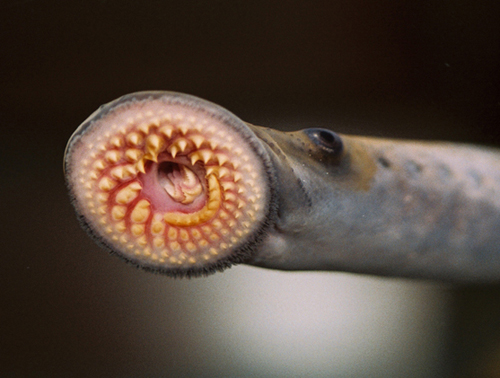
Life Cycle and Reproduction
Sea lamprey have an indirect life cycle lasting between five and nine years. An indirect lifestyle consists of a larval stage during development and an adult stage. When it comes time for the adult sea lamprey to reproduce, typically in April, May, and June, mature adult sea lamprey migrate to freshwater streams and begin creating nests called “redds.” Research has shown that sea lampreys are guided upstream by pheromones released by larval ammocoetes burrowed into the banks or bottom of the stream (Beamish, 1980). Once the male and female sea lamprey find a suitable spot for spawning, they work together to make a nest. These nests are roughly one meter in diameter and 15 centimeters deep.
Once the nest is complete, the male and female sea lamprey align their cloacal openings and fertilization takes place externally (New York State Department of Environmental Conservation, 2013). The female sea lamprey lays between 30,000 and 100,000 eggs which are then fertilized by the male sperm (Cherry, 2011). Shortly after fertilization is complete, both adult sea lamprey die. The fertilized eggs then hatch a few weeks later and young ammocoetes emerge. Ammocoetes are a tadpole-like larval stage of the sea lamprey.
The larval ammocoetes float downstream with the current until
they find a suitable spot to burrow into the bank or the bottom of
the stream. The ammocoetes remain in this larval stage for three to
four years. During this larval stage, the ammocoetes filter feed on
algae and microscopic organisms that float by such as
green algae and
diatoms. During the third or fourth summer as
an ammocoete, the larva undergoes a change and develops a disk
shaped mouth and eyes. The sea lamprey’s kidneys also develop to
become more suitable for saltwater conditions (New York State
Department of Environmental Conservation, 2013).
These young sea lamprey then migrate back to the sea and begin the free swimming stage of their life cycle. The free swimming stage lasts for 12-20 months, and then the adult sea lamprey once again migrate upstream to start the reproductive cycle again (New York State Department of Environmental Conservation, 2013).
 Much
like sea lamprey found off the Atlantic coast, sea lamprey living
within the Great Lakes have a similar reproductive cycle. The adult sea lamprey living in the Great Lakes migrate to
streams to spawn. Once these adults find a suitable spot for
spawning, they build their nests and fertilization takes place.
Once the eggs hatch and the ammocoetes emerge, the ammocoetes float
down stream and burrow into the bottom or bank of the stream. After
the ammocoetes reach maturity, they migrate back to the Great Lakes
to begin the free swimming stage of their life cycle
Much
like sea lamprey found off the Atlantic coast, sea lamprey living
within the Great Lakes have a similar reproductive cycle. The adult sea lamprey living in the Great Lakes migrate to
streams to spawn. Once these adults find a suitable spot for
spawning, they build their nests and fertilization takes place.
Once the eggs hatch and the ammocoetes emerge, the ammocoetes float
down stream and burrow into the bottom or bank of the stream. After
the ammocoetes reach maturity, they migrate back to the Great Lakes
to begin the free swimming stage of their life cycle
For more information about the life cycle of a sea lamprey, visit the New York State Department of Environmental Conservation website.